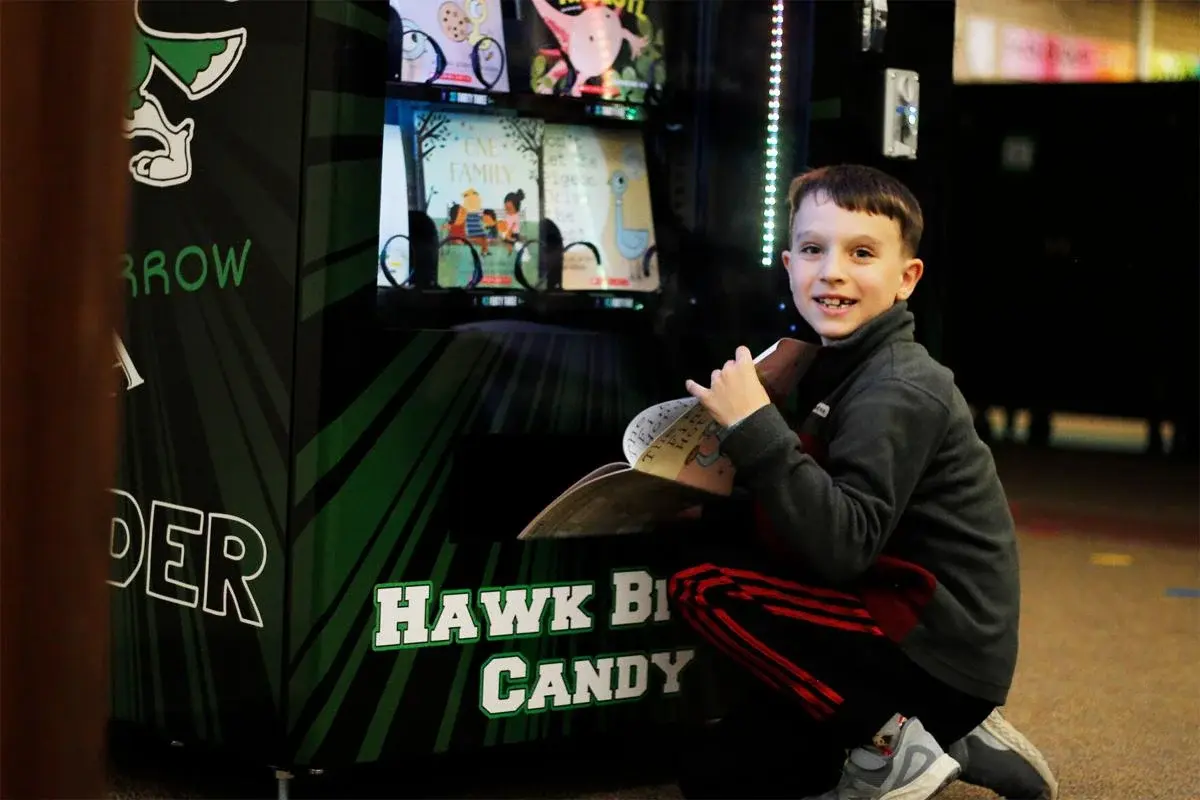Getting students to read for fun can be tough. With so many distractions competing for their attention, reading often gets framed as a chore instead of a choice. Once that mindset sets in, it becomes harder for students to connect with books in a way that feels natural or personal.
Librarians are often the ones who reshape that relationship. They create environments where reading feels rewarding again – sometimes through celebration, sometimes through quiet routines that help students see books as something worth returning to. Their role gives them the space to observe patterns, notice gaps, and try ideas others might overlook.
The most effective approaches reflect how librarians engage students in reading: with curiosity, creativity, and a focus on ownership over obligation.
Low-Cost Ways Librarians Engage Students in Reading
Some reading strategies don’t require funding – just attention, creativity, and a willingness to try something different. Here are three low-cost ways librarians have helped students reconnect with reading:
-
Creative Reading Incentives That Don’t Cost a Dime
-
Make Book Choice Personal and Powerful
-
Celebrate Reading Milestones as a Community
-
Invite Students to Shape the Library Experience
1. Creative Reading Incentives That Don’t Cost a Dime
When budgets are tight, even simple acknowledgments can shift a student’s attitude toward reading. Small touches like handwritten librarian notes tucked inside books, free-choice reading bingo cards, or “mystery reader” visits from faculty members help create a sense of novelty and recognition.
These ideas don’t rely on tracking points or offering prizes. Instead, they introduce moments that associate reading with encouragement. When students feel seen and supported, they’re more likely to come back for another book.
2. Make Book Choice Personal and Powerful
Giving students more control over what they read can reshape how they see reading itself. When librarians create spaces that support autonomy like:
- “Student pick” shelves
- Rotating displays based on reader input
- Informal review boards
Students feel more invested when they are involved. Even subtle signals can build trust. A student who sees a shelf curated with their interests in mind is more likely to engage in reading without pressure. Book choice becomes less about meeting expectations and more about finding something that feels right in the moment.
3. Celebrate Milestones as a Community
Students notice when reading accomplishments are acknowledged publicly. Some librarians build simple traditions such as:
- Monthly reading walls
- Classroom shout-outs
- Seasonal “reading celebrations”
These traditions let students share favorite titles and reflect on progress.
These routines give reading a visible place in school culture. That public recognition can turn private effort into a shared achievement, and students who feel proud of their progress are often more motivated to keep going.
4. Invite Students to Shape the Library Experience
When students take part in how the library is organized or presented, they often become more curious about what’s inside it. Suggesting display themes, nominating favorite books, or helping decide what goes on the “top picks” shelf can lead them to titles they may not have noticed otherwise. These small decisions turn browsing into something active.
Even hands-on roles like arranging books or decorating reading spaces help students spend more time around the collection. The more familiar and personal the space feels, the more likely they are to slow down, explore, and find something to read.
Reward-Based Strategies That Make Reading Exciting
Some students respond best when reading is tied to a moment of recognition, something that makes their progress feel seen. When rewards are thoughtful and tied to effort, they can help shift reading from obligation to celebration. For librarians looking to create that kind of energy, a few schools have turned to a tool that adds structure to that recognition: a rewards-based reading program. Examples include:
-
ClassDojo – A digital platform that allows classes to log reading and award points for positive behaviors, such as reading in class. Students with enough points can earn perks like lunch with the teacher or picking from a prize box.
-
Monthly reading challenges – Programs like Pizza Hut’s Book It! allow kids to work toward free pizza by reaching a certain number of books, pages, or minutes read.
-
Classroom behavior charts – The ol’-fashioned name-on-the-wall system to track student reading progress
-
Book vending machines – Students earn tokens through attendance, good grades, or positive behavior.
Why Use a Book Vending Machine if You Already Have a Library?
Both the library and the vending machine serve a purpose. A school library offers free books to borrow, helping students develop responsibility and consistent reading habits.
A vending machine offers students a chance to own a book outright — usually by earning a token through positive behavior or academic progress. This kind of system can support motivation while also giving students something lasting to take and build their own home libraries. Together, the library and vending machine give students multiple ways to access books and feel supported in their reading.
Using a Book Vending Machine to Motivate Young Readers
Several schools have adapted the vending machine idea in different ways, each with its own goals and outcomes:
Noonan Elementary (TX): Making Books a Reward, Not a Requirement
Pamela Gonzalez introduced a vending machine that runs on gold tokens earned through positive behavior. Students get to choose a book to keep, and the experience feels personal and earned. “It’s a great way to encourage students to open a book and see what it’s all about,” she says.
Harrison Elementary (WI): Letting Student Interest Drive the Machine
Reading specialist Megan Schultz filled their machine with high-interest books across genres. Every student got one token in year one. After that, students are encouraged to earn two tokens per year by reaching reading or behavior goals.
Chief Payepot School (Canada): Centering Identity and Access
With the school library repurposed for classroom space, a vending machine became the new hub for book access. Principal Nicole Crowe curated titles with a focus on indigenous authors so students could see themselves in the stories they chose.
FAQs About Student Reading Engagement
Librarians use a wide range of reading engagement strategies, but some questions still come up as schools try to support stronger, more lasting student reading habits. Q: How can I track reading to measure the success of these engagement strategies?A: Most libraries don’t rely solely on test scores to track success. They monitor circulation data, noting which books are being borrowed and how often students return. Some schools use informal tools like reading logs or goal-setting sheets to keep an eye on student progress without adding pressure. Student behavior and feedback matter just as much. When kids recommend books to peers, revisit the library more often, or start conversations about what they’re reading, that’s a sign those student reading habits are becoming internalized. These small shifts help librarians understand which approaches are truly motivating. Q: What role do parents or caregivers play in supporting school-based reading efforts?A: Parents and caregivers often support reading in quieter ways. When librarians share reading milestones or book suggestions with Mom and Dad, it builds continuity between the library and a student’s everyday life. These simple efforts help families encourage reading without turning it into another assignment. Some schools include families in broader school library activities. That might mean reading nights, take-home challenges, or public library partnerships. When students see reading encouraged at home and at school, their reading motivation tends to grow in a way that feels personal, not forced. Q: How do librarians adapt these strategies for reluctant teen readers?A: With older students, especially reluctant readers, the strategies change a bit. Librarians focus even more on autonomy — letting students choose what to read without pressure. Displays, book clubs, or even casual “if you liked that, try this” chats help students engage in reading on their terms. Relevance drives interest. Titles that reflect identity, current issues, or hobbies feel less like homework and more like personal discovery. These age-appropriate reading motivation for students tactics make it easier for teens to re-engage without feeling judged — especially when the library feels like a space made for them. |
When Reading Feels Personal, Engagement Follows
Librarians see the small moments others might miss. A student who lights up after finding the right book. A quiet win when someone asks for a second recommendation. These moments guide how reading becomes part of a student’s routine.
The most effective strategies rely on consistency and care. When reading reflects a student’s interests, identity, or effort, it starts to feel like something worth choosing again. Those experiences shape habits that stay with students beyond the classroom.
Looking for Funding Support?
If you're exploring a book vending machine but need help securing resources, this free guide can walk you through the grant process.
This article was originally published in August of 2024 and was recently updated to reflect current industry trends.


